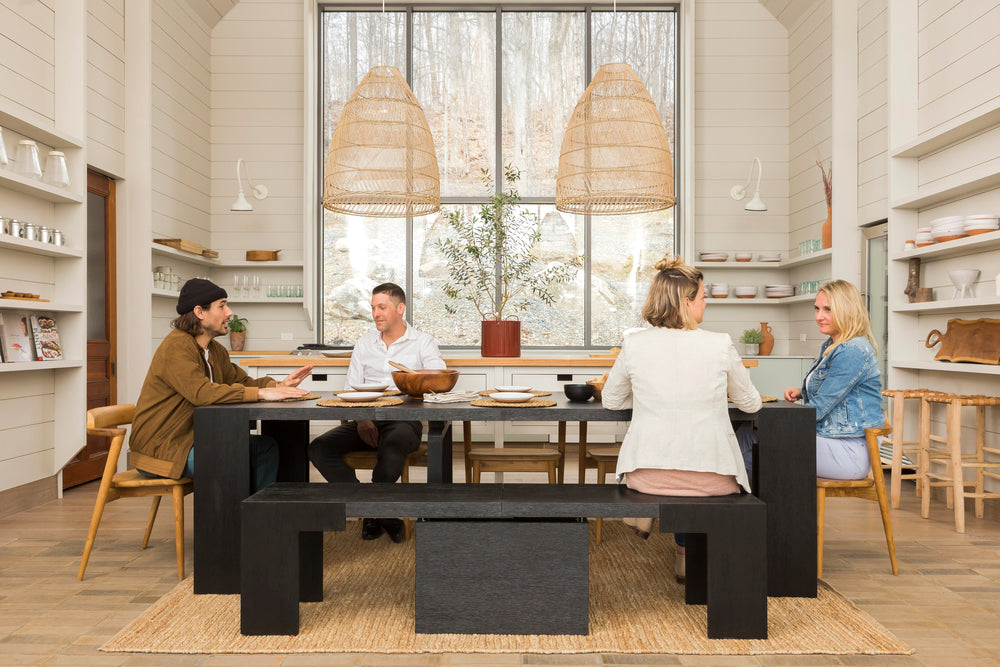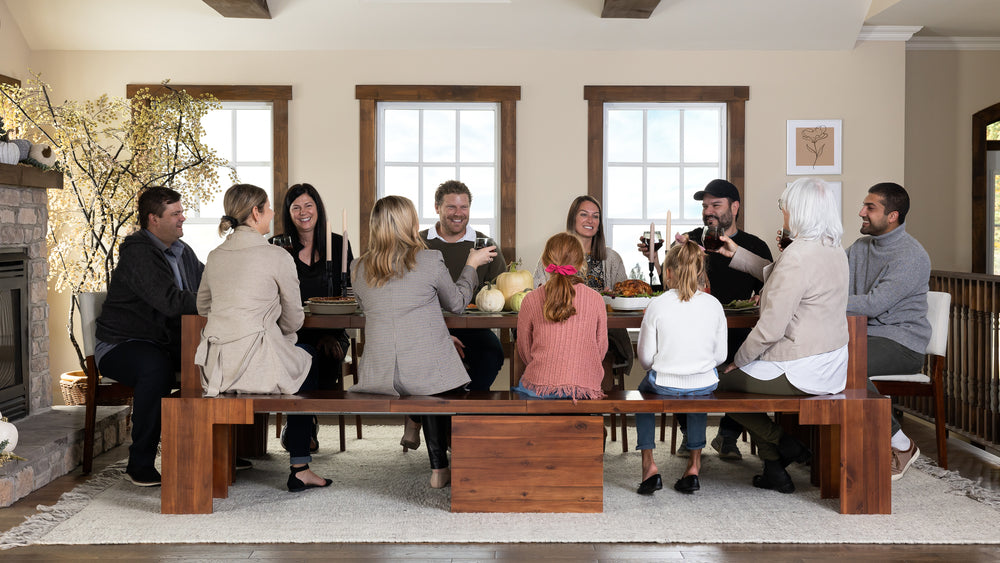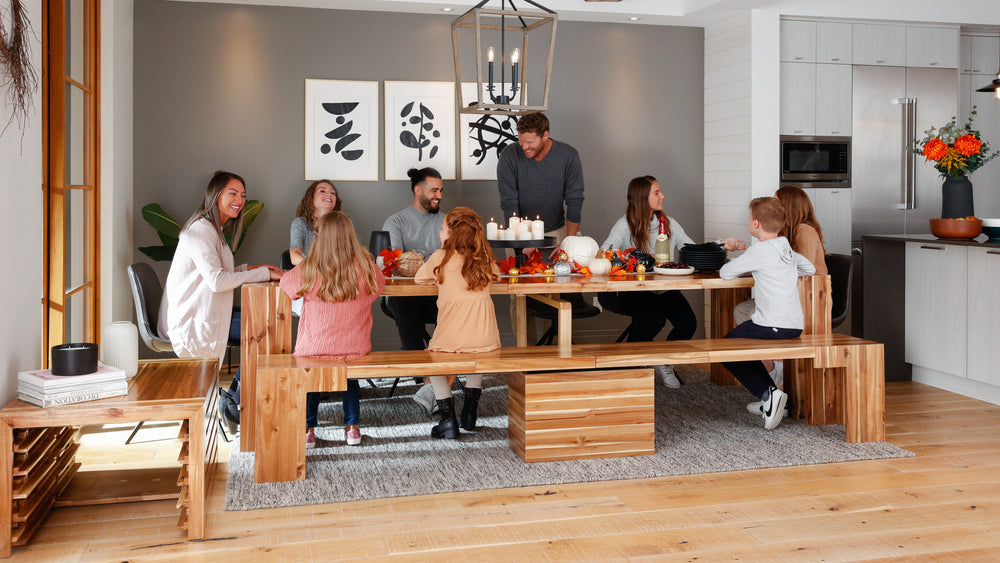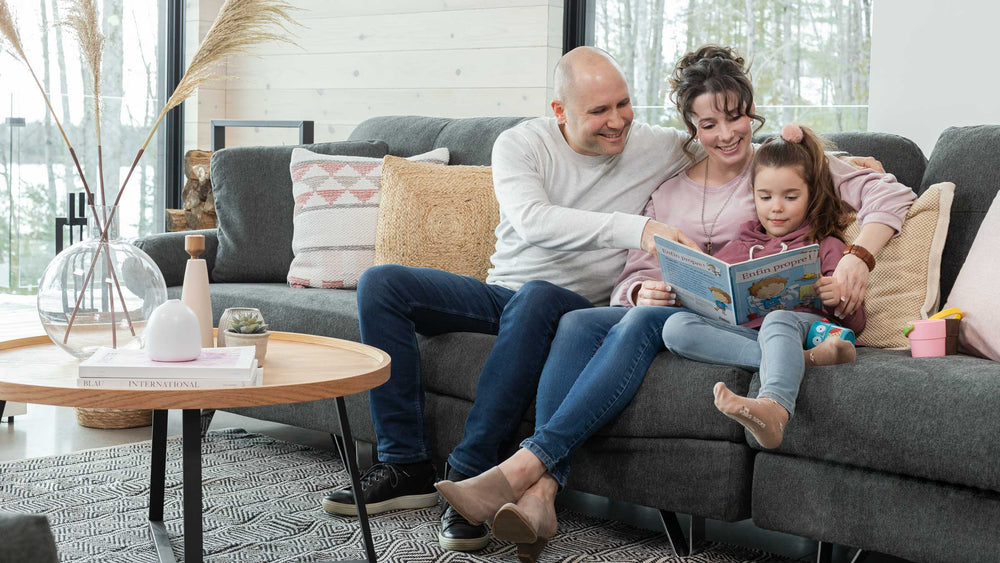
How to Clean Oak Furniture

January 04, 2024
Oak, being a natural material, is a common choice for sturdy and resilient furniture with timeless, aesthetically pleasing finishes. Cleaning oak furniture can be either an intricate or straightforward process as it largely depends on the blemishes it sustains.
Top tips for caring for your oak furniture

Caring for your oak furniture requires knowledge of two things:
Where is my furniture going to be situated?
What would I need to maintain the quality of the wood?
Avoid direct sunlight and extreme temperatures

First, you should avoid placing oak furniture in areas of extreme temperatures. Direct sunlight will fade the finish of your piece, and a consistent heat source (such as a radiator, air conditioner, the heat from the fireplace, etc.) will dry out your furniture. It's also unwise to leave your furniture outdoors unless it's specifically designed for such use.
Spacing your furniture by the wall
The amount of space required for a good amount of airflow is minimal, and you should leave around 1 - 1.4 inches of space between the furniture and the wall to keep your furniture temperature stable and properly ventilated.
This is especially required if your oak furniture is new (it may have been oiled before shipping and packaging and may have a pungent odor remaining). A quick fix for this would be to leave a bowl of baking soda, white vinegar, and charcoal on top to help alleviate the odor.
Minor tips to increase longevity and maintain quality furniture

Scuff prevention is also an important aspect of preserving the longevity of your clean oak furniture. Felt pads should be placed at the bottom of your furniture legs so that in the event you decide to move, they can be gently lifted without damaging your floors or the piece itself.
Never pull or drag your furniture! This is especially true for wooden floors, as felt pads protect both your furniture and the solid wood floor.
If you've got an oak dining table, you may want to avoid placing any hot dishes, pots, or pans directly onto the surface. Concerning drinks such as wine, beer, etc., it would be best to use coasters or beermats to prevent any would-be stains.
Here at Transformer Table, we have some brilliant, fuss-free modular furniture to suit any spatial concerns that you can learn all about here.
You may also want to take a look at some beautiful Canadian Dark Oak furniture Transformer Tables on offer :
The practical
The Gathering
How to wax oak furniture
Waxing your oak furniture every six months is good practice. Waxing protects the wood grain, making your wood crack resistant, and ensures quality furniture with excellent longevity.
Waxing is a simple process that can be done in your home. Test the wax on the part of your furniture that isn't in plain sight, such as underneath your oak table or within a drawer.
Provided you're satisfied with the finish, apply the rest of the wax in the same direction as the grain. Leave it to rest for 5 minutes (enough time for a quick beverage), then buff the wax off again by going in the same direction as the grain.
The simplest method of cleaning oak furniture

The most straightforward method to clean your oak furniture is to use a clean, damp but not wet cloth. You may also use your preferred hardwood cleaning product (although the traditional way to clean oak furniture is less risky - we'll get into this momentarily) and then rub clean with a dry cloth.
Clean up spills as soon as possible. Water stains quickly due to the porous nature of oak, and spills will damage the finish of your furniture, so it is best to clean any spills immediately to prevent stains. Simply wipe the spills on the surface with a dry, soft cloth.
A safer alternative to cleaning products - Cleaning oak furniture with vinegar

Vinegar is the most traditional ingredient in any stain-busting concoction due to its mild disinfectant properties and ability to get through grease. There are two ways to make use of vinegar to clean your oak furniture.
The most simple process :
-
Fill one cup of warm water and mix in three tablespoons of distilled white vinegar.
-
Take a clean, soft cloth and dampen it in the mixture. Using the slightly damp cloth, dab it onto a test spot and continue if it has no adverse effects. Remember, the acidic nature of the mixture ensures that you need not scrub the surface harshly, so a gentle wipe is all it takes.
-
Finally, buff with a gentle dry cloth.
An alternative mixture requires a natural product found in almost any kitchen - olive oil!
-
Mix two parts of olive oil with one part of vinegar.
-
If possible, use a spray/trigger bottle (one you may have wanted to use for your garden or just lying around the detergent cupboard would work) and spray a thin layer evenly onto the oak surface.
-
Use a soft, clean cloth and gently rub the mixture in. The olive oil provides much-needed moisture to the surface and works in tandem with the potent cleaning abilities of vinegar.
These two methods are much safer and more environmentally friendly than traditional cleaning products.
How to remove stains from an oak table
Finding a stain on your precious wood furniture is an absolute nightmare. However, there's no need for panic, as there are many solutions to getting a variety of stains out of your furniture, although they largely depend on the type of stain.
Using mayonnaise to remove water stains
Believe it or not, mayonnaise is a tried and tested method for removing water stains. It also doesn't require a lot of effort, even for tough stains, as you'll see below:
-
Dab a small amount of mayonnaise into the affected area. Depending on the severity of the stain, you may leave it in as little as half an hour, or for tough stains, overnight seems best.
-
The oil in the mayonnaise will get to work, displace the water, and get rid of any pesky cloudy residue in the finish of the oak wood.
-
After it has sat for the appropriate amount of time, wipe the mayonnaise up with a cloth, and if it looks substantially better, use a wax or polish to restore the surface of the oak.
Removing stains with toothpaste and baking soda

If mayonnaise proves ineffective on tougher stains, there is always an alternative method that will lift tough spots on the wood.
-
To effectively use this method, dab an appropriate amount of toothpaste on a damp cloth, then gently rub the toothpaste onto the stain.
-
Continue to rub until the stain is removed, then wipe away with a gentle cloth or paper towel.
-
Since toothpaste contains a mild abrasive, it should work by itself, but if the stain proves to be particularly tough, use baking soda as an extra abrasive and add a little to the toothpaste. Rub incrementally harder until the stain is completely removed.
Removing dark stains from wood

Cleaning wood furniture often involves dealing with dark stains if your furniture has a substantial level of damage.
This process may require a bit of elbow grease to restore your Oak and remove stains.
Start with stripping the finish from the wood by using fine sandpaper, and gradually apply extra pressure until the stain has been removed - try not to sand too harshly at first as you're essentially subtracting the wood.
After stripping and sanding the finish, your oak is more likely to absorb dirt at this stage, so you need to re-finish the surface with wax or oil.
Let the finish soak in and buff with a soft clean cloth for a perfect finish.
Conclusion
Because oak is a natural material, unfortunately, it stains, but hopefully, this has highlighted a few tips and techniques to leave your oak furniture in pristine condition for many years.



